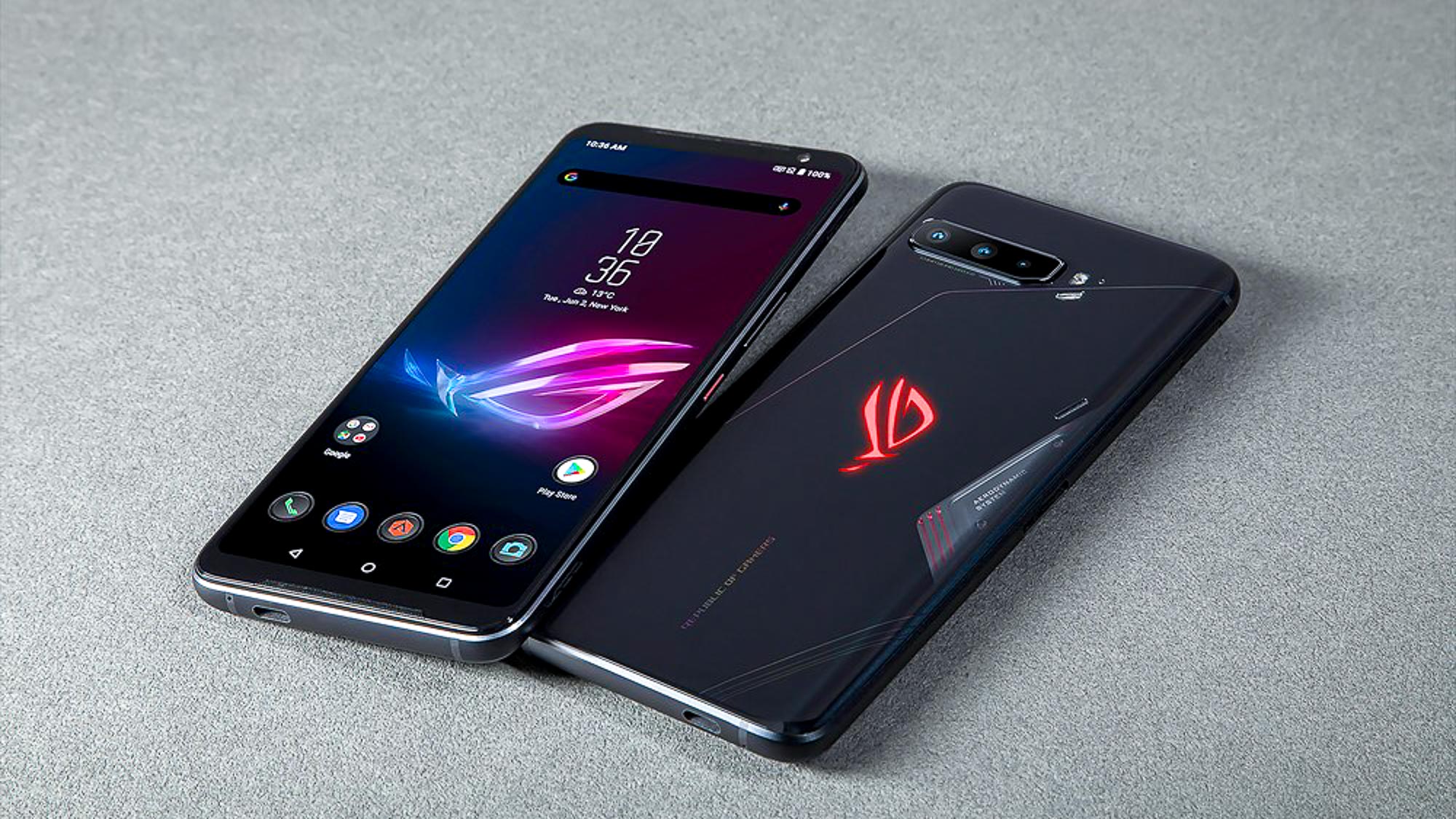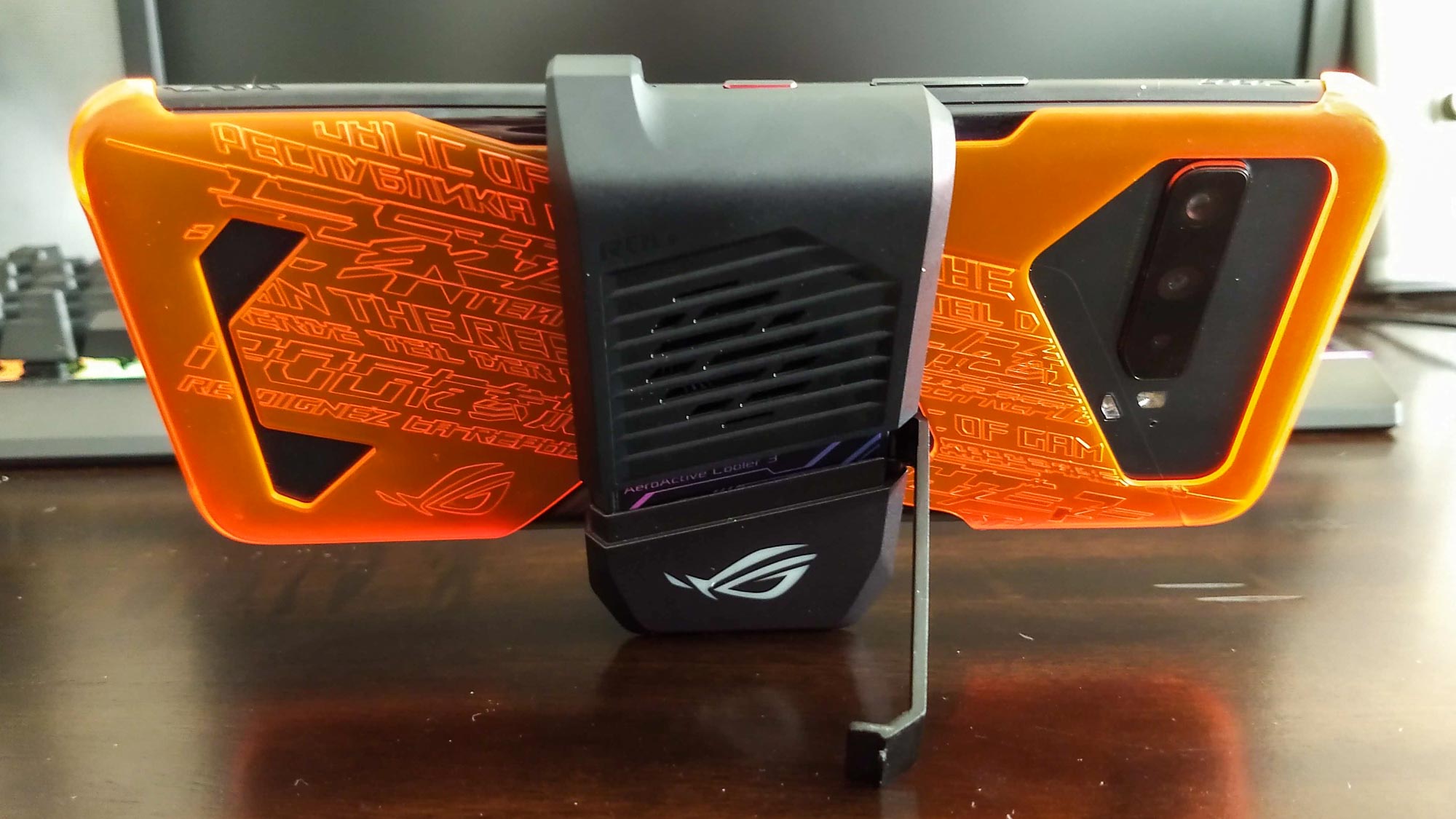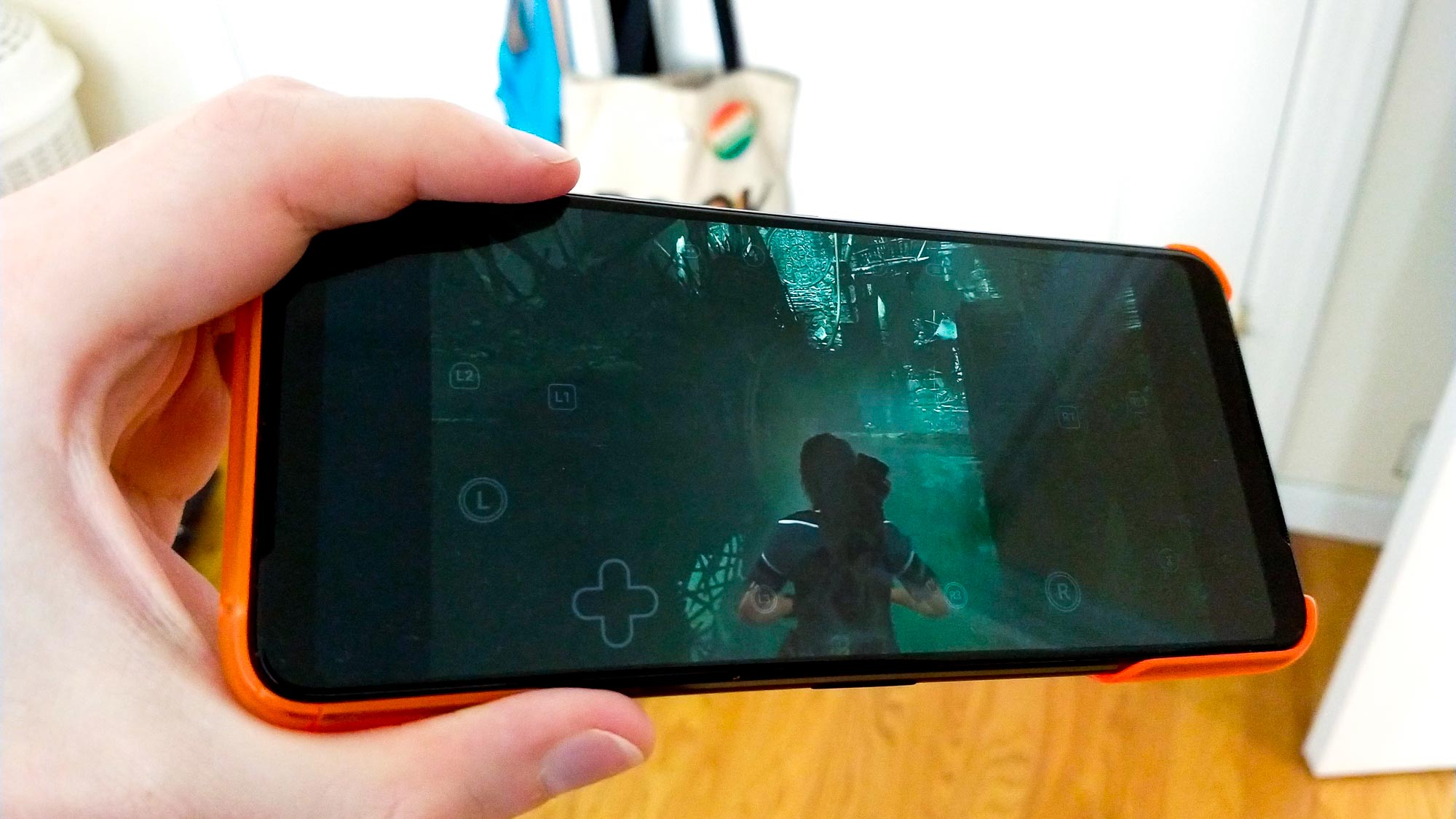Tom's Guide Verdict
The Asus ROG Phone 3 is a powerful and robust Android gaming phone, although it gets hot easily and can be cumbersome to use. It’s surprisingly well rounded for a gaming-focused handset, though buyers interested in other luxuries, like camera quality, may want to consider a more traditional flagship phone like the Galaxy S20 or OnePlus 8 Pro instead.
Pros
- +
Powerful gaming performance
- +
Long battery life
- +
Pretty display
- +
Useful native software
Cons
- -
Gets hot quickly
- -
Extremely expensive (probably)
Why you can trust Tom's Guide
Starting price: €999 ($1,184)
Display: 6.6-inch AMOLED (2340x1080; 144 Hz)
CPU: Qualcomm Snapdragon 865 Plus
RAM: 12GB, 16GB
Storage: 512GB
SD Card slot: None
Rear cameras: 64MP wide (ƒ/1.8), 13MP ultrawide (ƒ/2.4), 5MP macro (ƒ/2.0)
Front camera: 24MP (ƒ/2.0)
Battery: 6,000 mAh
Charging: 30 watts
Security: Fingerprint sensor, PIN
Operating system: Android 10
Size: 6.7 x 3.1 x 0.4 inches
Weight: 8.5 ounces
The Asus ROG Phone 3 may not be as powerful as the upcoming PS5 or Xbox Series X, but it's a heck of a lot more practical. Think about it. Which is going to get more use: A device that you have to hook up to your living room TV for games and movies, or a device that you can take with you absolutely anywhere and use for any number of productivity and leisure activities?
And yet, the ROG Phone 3 isn't just the best gaming phone available right now; it's arguably one of the best handheld gaming consoles out there — provided you like Android games, at any rate.
As a gaming device, the ROG Phone 3 succeeds in just about every way. It plays high-end mobile games beautifully, and its built-in software gives you all the tools you need to customize and optimize your experience. Long battery life means that you can game for hours, and a handy included fan/kickstand makes it easy to hook up a controller and play for hours. Naturally, since the phone is so powerful, it also excels at most day-to-day tasks.
Granted, the ROG Phone 3's ambitious specs come with some drawbacks. The phone heats up very easily when gaming, and using the fan to keep it cool creates a whole new set of problems. It's also possible to chew through the battery pretty fast, depending on how fancy you want your games to look. The phone's sheer size makes it a little unwieldy for everyday use — but it's still not quite big enough to stream PC or console games in great detail.
Still, if you want a gaming system that also happens to be a well-rounded smartphone, the ROG Phone 3 is a compelling, albeit potentially expensive, choice. Read on for our full Asus ROG Phone 3 review.
Asus ROG Phone 3: Price and availability
The Asus ROG Phone 3 is not widely available yet. There’s no official U.S. pricing for the ROG Phone 3 right now, and there won't be until September. In the meantime, Asus France has listed the 12GB RAM variant for €999 ($1,184) and the 16GB RAM variant for €1,099 ($1,302). Both come with 512GB of storage, and there’s no SD card slot to expand that further. Granted, phones in Europe tend to be a little more expensive than phones in the United States, but we still wouldn't expect the ROG Phone 3 for less than $1,000 when it makes its way here.
Asus ROG Phone 3: Design
The first thing I noticed about the ROG Phone 3 is that it's enormous. The phone itself is 6.7 inches long, which will surely try even the deepest pockets. It's also quite heavy at 8.5 ounces. Carrying it around can be a pain (almost literally), and it's not easy to hold for long periods of time — for the heat as much as for the weight, but we'll get to that.
Get instant access to breaking news, the hottest reviews, great deals and helpful tips.
While I never did quite get used to the screen's ratio, the ROG Phone 3 is a pretty device otherwise. The front of the device is almost all screen, with small black bezels on the top and bottom. On the right, there's a power button and a volume button. On the back, there's a shiny reflective surface with a tasteful ROG logo in the center. While the phone is a bit of a fingerprint magnet, I do have to give it credit for some of its subtle aesthetic choices.

The left side of the phone is where things get interesting, as there's a hard-to-remove plastic plug that reveals a proprietary port. This is where the fan plugs in, and I can safely say that the ROG Phone 3 is the very first smartphone I've ever used to come with its own external cooling system.
While the fan enables some cool features (and is downright necessary to play demanding games at higher settings), I found myself less thrilled with the device than I'd hoped. First off, the fan can be a real pain to connect and disconnect, between the hard-to-remove rubber plug, extendable clamp and very tight kickstand. While the fan is not that loud on its own, it's close enough to the phone's mics that it can be extremely disruptive if you get a call or need to record something. It also drains the battery to the point where you'll probably want to plug in when you use it.
Asus ROG Phone 3: Display
The Asus ROG Phone 3 features a 6.6-inch, 2340 x 1080 AMOLED screen, which supports frame rates up to 144 Hz. I never quite got used to the extremely wide 19:5:9 aspect ratio, but otherwise, it's a gorgeous display, with rich colors: 168% of the sRGB spectrum, to be precise, with a Delta-E color accuracy score of 0.31. The latter even beats out the Samsung Galaxy S20 Plus’ Delta-E score of 0.36. (Numbers closer to zero are better.)
In terms of brightness, the screen can get up to 419 nits under ordinary circumstances, and up to 646 nits with automatic brightness on. Considering that even computer monitors tend to max out somewhere around 350 nits, the ROG Phone 3 is plenty bright, and I had no trouble reading the screen in broad daylight.
The phone's frame rate is what really sets it apart from non-gaming models. Generally speaking, it's a huge boon in demanding games, and not really necessary otherwise. But it's also easy to control, thanks to Asus's proprietary software, so it does no harm, at worst, and a lot of good, at best.
Asus ROG Phone 3: Camera
With three powerful rear cameras and one high-res front camera, the Asus ROG Phone 3 doesn't skimp on picture quality. At the same time, it's arguably not up to the standards of a phone that sells itself on its camera, such as the iPhone 11 Pro or the Pixel 4.
Without going into excruciating detail about the cameras, the three lenses on the back comprise a 64-MP primary shooter, a 13-MP ultrawide one and a 5-MP macro, respectively, while the one on the front is rated at 24MP. There are a respectable number of options for taking photos and videos, including Pro Video, Time Lapse, Motion Tracking, Portrait, Night Mode and Macro — which is particularly interesting, since it lets you get ultra-close-ups, within just a few inches of your subject.
Since I don't think many people will be buying the ROG Phone 3 primarily for its camera, I spent most of my time in its general Photo mode, and was reasonably pleased with the results. Indoors shots were sharp, although the color balance felt a little washed out, particularly when the camera had to balance a lot of different colors at once, as in the case of books or DVD cases. Outdoor shots fared much better, with more naturalistic color balance — although reds felt supersaturated and not as lifelike as greens, whites and blues.
The ROG Phone 3's camera options are neither as subtle nor as extensive as what you'd get from a dedicated camera phone, but it does boast some very powerful hardware and enough tweakable options that you can do some impressive photography with it, if you're so inclined.
My one big complaint was that no matter what I did, the camera would not automatically rotate horizontal shots. If you take a lot of pictures and need to upload them later, having to rotate them manually, one at a time, is an enormous pain, and something that barely any other phone forces you to do. I can't imagine why Asus made this baffling choice, and I hope a future software update offers some kind of auto-rotate option.
Asus ROG Phone 3: Performance
A gaming phone — particularly one that costs more than $1,000 — lives or dies by its performance, and the Asus ROG Phone 3 has a lot to offer in this category. Let's get the easy stuff out of the way first: Everyday tasks are effortless on the ROG Phone 3. Social media, calls, texts and so forth pose no challenge to a system that's geared for gaming, so navigation is quick and responsive, videos are smooth and colorful and if there's an app that the phone can't handle, I couldn't find it.
In terms of artificial benchmarks, the ROG Phone 3 scored 3,393 on the Geekbench multi-core test. Compare and contrast to the Samsung Galaxy S20, which scored 3,147, and the iPhone 11 Pro, which scored 3,509. With its Qualcomm Snapdragon 865 Plus processor and up to 16 GB RAM, the ROG Phone 3 is one of the most powerful phones on the market, although Apple's A13 chip seems to still have a slight edge.
The more interesting question is how the ROG Phone 3 handles games, and the answer is: extremely well, with one moderate exception. The timing on this ROG Phone 3 review worked out extremely well, as Bandai Namco has just released Tales of Crestoria: an intricate mobile RPG that can take full advantage of powerful phones with detailed and demanding graphical settings. (More Western fans really need to play the Tales series, but I digress.)
As someone who's been playing the Tales series since the PlayStation days, I can safely say that the ROG Phone 3 made Tales of Crestoria look better than any of the series entries on the Xbox 360 or the PS3; the character models gave the PS4 entries a run for their money. Battles were fast and fluid, even when characters launched one particle-effects-laden special attack after another, and the colorful screen made every character look unique and full of personality. The system's robust speakers also gave me a lot of control over the volume level, and sounded surprisingly good for music, voicework and sound effects.
The ROG Phone 3 also plays very nicely with game-streaming services, such as Google Stadia and Nvidia GeForce Now. In my tests, games like Shadow of the Tomb Raider and Doom Eternal ran very fluidly, although the screen was still too small — and perhaps a little too dark — to make out a lot of the fine details necessary for those games. It's a workable option if you need a second screen, although a tablet would probably work better.
What helps Tales of Crestoria, and other demanding games Android like PUBG and Fortnite, excel is the ROG Phone 3's Game Genie overlay software, as well as its optional X Mode. Without going into excruciating detail about either function, Game Genie (not to be confused with the '90s cheat code generator of the same name) is a simple overlay that lets you optimize your games as you play them.
By simply swiping from the left of the screen, you can use the Game Genie to control frame rate, brightness and other performance metrics for any Android game. You can also tell it to block calls and texts while the game is open, if you want some uninterrupted gaming time. Game Genie doesn't slow down games at all, and it's trivially simple to use. It's a smart and functional way for the ROG Phone 3 to distinguish itself as a "gaming phone" beyond just offering powerful specs.
X Mode, on the other hand, is a way to sort of supercharge the system specs at the cost of heat output and battery power. There are three different levels, which get progressively more powerful as you go. Level 3, in fact, requires you to plug in the fan, or it won't even activate. X Mode is a worthwhile option, although generally speaking, even the most demanding Android games are well within the ROG Phone 3's regular parameters, so I wonder how useful it will be.
(If you decide to use the ROG Phone 3 as an emulator, of course, your performance requirements may vary. But since that's legally murky territory, that's all we can say about it here.)
X Mode does highlight the biggest problem with the ROG Phone 3, however: It generates a massive amount of heat. The phone comes with a rubbery grip that covers the back of the device, and I learned quickly that it's not just for show. After gaming for a while, without the grip, the phone feels almost too hot to touch. Overheating can be a problem for games like Tales of Crestoria, which crashed frequently once the phone started to get too warm. The fan helps mitigate this problem, to an extent, but that also means you'll need a cumbersome, battery-draining attachment to facilitate the phone's primary activity.
Gaming phones are going to get hot; there's no escaping the laws of physics. But when it gets hot enough to regularly crash games, the tradeoff feels less worthwhile.
Asus ROG Phone 3: 5G connectivity
The Asus ROG Phone 3 supports 5G from most GSM-based networks in the United States, including AT&T and T-Mobile. (The phone doesn't support Verizon mobile networks, as I learned the hard way after trying to insert my own SIM card.) I don't live near a 5G hotspot, and was unable to test this connectivity firsthand, but subscribers who have access to this technology should be able to leverage it with the ROG Phone 3.
Asus ROG Phone 3: Battery
One thing that consistently impressed me about the Asus ROG Phone 3 was its battery life. In our Tom's Guide battery test, which sets the screen brightness to 150 nits and measures how long it takes the phone to run down while continuously browsing the Web on an LTE network, the ROG Phone 3 lasted for an impressive 14 hours and 30 minutes. Compare and contrast to the 9 hours and 31 minutes you get from a Galaxy S20 or the 10 hours and 24 minutes you get from an iPhone 11 Pro, and the ROG Phone 3 has a big edge in this category.
Granted, its 6,000 mAh battery contributes to the phone's weight, and you'll never get 14 hours of uptime if you use the phone primarily for gaming. But it's an impressive number nonetheless. The phone can fully charge in less than three hours with a standard 5V charger, although it doesn't support wireless charging.
Asus ROG Phone 3: Software
The Asus ROG Phone 3's most important pieces of software are its Game Genie and X Mode features, discussed in the Performance section above. From an OS standpoint, the phone runs an extremely clean installation of Android 10. However, the phone gets software updates from both Google and Asus, since X Mode and certain other gaming features are built right into the OS itself.

Asus has not discussed just how long it plans to support the ROG Phone 3 with security and performance updates. However, based on its strategy with the original ROG Phone and the ROG Phone 2, buyers should expect at least one year of support, and perhaps no more than two years. Unfortunately, there's no standardized amount of time for Android phones to receive support, so we can only say that this is (probably) less than the three years of support offered by Google and Samsung.
Asus ROG Phone 3: Verdict
Our Asus ROG Phone 3 review discussed how the device runs hot, and how it will likely be extremely expensive once it hits the United States. But in spite of a few shortcomings, the ROG Phone 3 accomplishes almost exactly what it sets out to do. It runs demanding Android games beautifully, and gives users a set of intuitive, flawlessly integrated tools to optimize their experiences.
At the moment, there aren't many true "gaming phones" on the market, since Razer seems to be out of the picture for right now, and Xiaomi's models are a little niche and not sold in many parts of the world. As such the ROG Phone 3 is one of the only viable options if you want a phone that's a game console first and an everyday accessory second.
In the same price range, it's still worth considering the Galaxy S20. That phone's raw power is enough to run just about any Android game you'd want, and the camera takes much prettier pictures. But who needs pictures when you've got a portable console in your pocket?

Marshall Honorof was a senior editor for Tom's Guide, overseeing the site's coverage of gaming hardware and software. He comes from a science writing background, having studied paleomammalogy, biological anthropology, and the history of science and technology. After hours, you can find him practicing taekwondo or doing deep dives on classic sci-fi.
